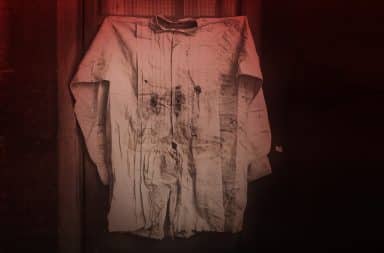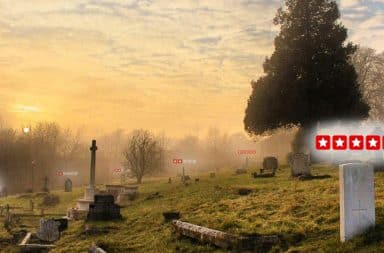Throughout history, our religious scriptures, folklore, and even stretching as far back as cave finger-paintings that our ancestors' dads probably wouldn't hang on the refrigerator no matter how many stars Miss Williams put on them, have been riddled with mentions of ghosts, goblins, and gay marriage, as well as other horrifying propositions. Before you dismiss superstition as a sentiment of the past, you may be further spooked to hear that even today, 45% of Americans believe that ghosts are real, 55% of Americans do NOT think marriage should be exclusively between a man and his lack of options because he didn't wear a condom, and my dad still hasn't hung anything on the fridge you cold, cold bastard.

(Father nodding in approval not pictured.)
No matter how many Americans believe ghosts exist, shut the fuck up, you didn't see a ghost or anything supernatural for that matter. Here's why.
1. Our minds are just playing tricks on us.
Bloody Mary. Mary Poppins. Papa Smurf. Where am I? Have you ever tried looking into a mirror and taunting that ho out by repeating her name? No, I mean Bloody Mary. Well, of course you haven't because you're here. But if you had, you'd have noticed that it actually works. You may not get Smash Bros'd into oblivion by an angry ghost, but if you look into a mirror long enough, you'll start to notice your face distorting and becoming increasingly unnerving—unless of course you're Bruce Jenner, then you'll just notice yourself.
Why is this?
It's called the Troxler Effect, which basically just means that when your eye fixates on a given point, other points begin to fade away. Try it: stare directly at one number on the keyboard and watch the others fade like Arcade Fire in three weeks.
What happens when you look at your face in the mirror is that there isn't a fixed point, so your face starts get all cray, cray and starts to disappear and re-appear erratically. In a study done at the University of Urbino, all participants who tried this noticed their faces changing, while almost half reported seeing a "monstrous" image.
2. We're programmed to assume something's haunting us.
In our evolutionary past, if we saw a shadow and assumed it was nothing, it could possibly be a tiger and that tiger would melee our asses. On the other hand, if we saw a shadow and assumed it was a tiger, but it wasn't, upon further investigation, we'd figure it out and move on, sans ass melee. That's why we've evolved to assume agency instead of the opposite.
Drawing upon 30 years of research into why we believe what we do, author Michael Shermer explains that we first form beliefs for irrational reasons to ensure our survival, then try to rationalize them later. In the same way, because predicting our environment was so paramount to fitness, we fall victim to conceiving patterns where patterns don't exist. The issue is, there are a host of biases that prevent us from refuting that belief once held. It takes longer for us to refute a belief than to ratify it, and in what is called the assimilation bias, we are partial to information that supports what we believe, and dismiss that which doesn't support what we believe.
Most of us don't have to worry about tigers anymore, so when we see that shadow, we still assume it was some sentient creature. And that fear we feel, which is never solidified by a real encounter (because unlike tigers, ghosts of course don't melee people's asses), is rationalized by our delegation of its presence to a mysterious shadow person. Furthermore, because of the assimilation bias, we attribute patternless creaks and slamming doors to ghosts, but disregard the coincidental wind and pissed off teenagers that are their real source.

This Tiger hasn't melee'd an ass in a while.
3. Children and dogs are spazzes.
One commonly espoused idea often touted as an uncontestable fact is that children and animals are more open-minded and less prone to fall victim to social expectations. Thus, they would of course be more sensitive to and as a result, natural experts on, supernatural experience. Other than the fact that's basically like saying just because a Jersey Shore cast member is more likely to get chlamydia, he or she is more qualified on antibiotics than Alexander Fleming, kids and animals like totally blow at separating fiction and reality.
There are a couple of brain regions in particular implicated in our recognition of real or conceived characters, namely the anterior medial prefrontal cortex and the posterior cingulate cortex. It appears that our appraisal of someone's reality is largely autobiographical. That is, you know Barack Obama is more real than Mr. Magoo since he is more personally relevant, because Mr. Magoo isn't a Kenyan Muslim Socialist bent on crucifying the Constitution on a flaming cross fashioned out of the limbs of small business owners and unborn children.
Hebb's law says, "Neurons that fire together, stay together." Not only are these regions underdeveloped in children, but they cannot as easily separate fact from fiction, since the concrete associations we gain with experience have not come about yet and are therefore partial to the imaginative. In play, both children and animals have been shown to act "as if" as an initial way to reproduce reality, and are more likely to anthropomorphize objects, even if the objects aren't very realistic at all. It's easy to see how kids could construct a narrative and become unsure of its veracity later.
On the subject of animals, we can't possibly know what makes them tick all of the time. They have a completely different sensory experience, also called Umwelt. Dogs have an immeasurably better sense of smell than we do. So yes, your dog could be barking in the corner because there is an invisible spirit clanking invisible chains, but on the other hand, maybe someone pissed themselves there some wild night 20 years ago.
(Or maybe the ghost farted.)
4. Ouija boards are bullshit.
Everyone has a friend who's had a freaky Ouija board experience. Unless of course they don't have any friends, and in that case, haha what a freak!
The general consensus is that Ouija boards are conduits of demons and the dead to communicate with the living. Reasonable enough. Most people both don't know how a Ouija board works, nor do they really have any desire to learn if it was anything else than a smoky apparition (RIP Nate Dogg), because that would be insane. The only problem is, in reality, Ouija boards are like strippers: they look fun, but you end up doing all the work yourself.
Back in 1853, Michael Faraday showed that the movement of the pointers in Ouija boards was, surprisingly enough, not caused by ghosts or demons or even Jews, but by an ideomotor movement. That is, unconscious movements by the participant who, though not actively trying to move the pointer, still is. We have these issues with volition all the time: try not looking at a girl's boobs when she says, "Don't look at my boobs."
5. Ghost shows and horror movies perpetuate the myth in our minds.
The reason the scientific method works is because it is objective in its pursuits. Personal and professional agendas are limited by competing theories, double-blind studies, and constant re-evaluation; it is inherently self-correcting. The reason ghost shows work is because they don't use any of that.
There are currently too many ghost shows on nearly every channel ‘round-the-clock. Even when abandoning the objectivity of ghosts maybe not existing, as well as employing pseudoscientific tools that supposedly detect supernatural activity, but are probably just failed sex toys, still no one has found any conclusive evidence of the existence of ghosts. Can you imagine if we had ‘round-the-clock coverage trying to find evidence of a 22-year-old girl on Facebook who hasn't posted the serenity prayer? Can we try?

Professor Paul J. Patterson is an expert on the horror genre, he notes, "…each generation has defined horror, and it turns out largely on the idea of something outside of our understanding or threatening us." That is, what scares us is a reflection of the social constructs of the time: first it was Dracula, then Frankenstein, then women voting, and now zombies. With the fears of biological warfare and antibiotic-resistant bugs today, we've conceived these thought experiments that are movies, books, and other media as a means of confronting the impending doom we feel threatens us. You may be thinking, "Well, we know what comes out of the entertainment industry isn't real," but I'd ask you to remember back when Paranormal Activity was first released and how each one of your friends told you there was this sweet, new voyeuristic horror film that was super real which you only saw 10 minutes of because you realized it wasn't amateur porn.
Regardless, the dichotomy between our entertainment and actual reports of ghost sightings is false, anyway. Paranormal Activity didn't invent the poltergeist, Nosferatu wasn't the first mention of the vampire in history, and Stephen King sure as hell didn't conceive literally ever monster that has ever existed out of thin air. All of these stories were derived from real superstitions of real people who didn't understand their environment or brains during a time when dinosaurs and landlines roamed the Earth and personal experience wasn't commercialized then poorly adapted to screen, and these stories varied from culture to culture (as they would because different cultures faced differnet threats). There's the Civil War general ghost in the South; the Chupacabra in Mexico; vampires in Romania; and Sasquatch in the Pacific Northwest. If the things that go bump in the night existed independently of the human mind, they would bump in the night independently of the geographical region where the culture conceived them. Our ghost stories of today are just the fall blockbusters of tomorrow. So shut the fuck up about it, you didn't really see a ghost.

I take it all back.



